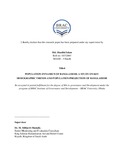| dc.contributor.advisor | Millat-E-Mustafa, M. | |
| dc.contributor.author | Islam, Md. Shariful | |
| dc.date.accessioned | 2019-09-09T07:43:38Z | |
| dc.date.available | 2019-09-09T07:43:38Z | |
| dc.date.copyright | 2019 | |
| dc.date.issued | 2019-06 | |
| dc.identifier.other | ID 18372003 | |
| dc.identifier.uri | http://hdl.handle.net/10361/12541 | |
| dc.description | This dissertation is submitted in partial fulfillment of the requirements for the degree of MA in Governance and Development, 2019. | en_US |
| dc.description | Cataloged from PDF version of dissertation. | |
| dc.description | Includes bibliographical references (page 46-48). | |
| dc.description.abstract | This study aims to analyze the demographic transition and the impact of these changes in the
coming years to provide opportunities for more meaningful policymaking in Bangladesh. It
analyzes the components of population structure from three perspectives: historical population
trends, current demographic profile and population projection. Data are collected from different
secondary sources.
Previous trends indicate that the population of Bangladesh has doubled in the period from 1971 to
2011. The growth rate has declined to 1.02% during the same period. The sex composition of
Bangladesh is also symmetrical in recent years, the age specific fertility rate indicates higher
adolescent fertility rate in the future. The current trend in age structure depicts a large number of
people entering the working age group. The trend in the net migration rate continues to rise as
employment opportunities in Bangladesh are insufficient and people tend to go abroad to improve
their standard of living.
Future projections indicate that the population growth rate will be steadily reduced until 2020,
after which there will be a sharp decline in the growth rate until 2050. Despite the low rate, the
total population will increase and the population is estimated to reach 201 million by the end of
2050. The current structure of the sex age population is pyramid shaped and it will take the view
of the barrel shape by 2050. By the end of the projection period, the size and share of the elderly
population will increase (60 +).
The study also depicts emerging windows of opportunity as well as the challenges faced by
Bangladesh. Furthermore, this study also focuses on policy recommendations that can help to meet
the expected challenges of the future. | en_US |
| dc.description.statementofresponsibility | Md. Shariful Islam | |
| dc.format.extent | 48 pages | |
| dc.language.iso | en | en_US |
| dc.publisher | BRAC University | en_US |
| dc.rights | Brac University dissertations are protected by copyright. They may be viewed from this source for any purpose, but reproduction or distribution in any format is prohibited without written permission. | |
| dc.subject | Population projection | en_US |
| dc.subject | Bangladesh | en_US |
| dc.title | Population dynamics of Bangladesh: a study on key demographic trends and population projection of Bangladesh | en_US |
| dc.type | Dissertation | en_US |
| dc.contributor.department | Brac Institute of Governance and Development, Brac University | |
| dc.description.degree | M. Governance and Development | |

